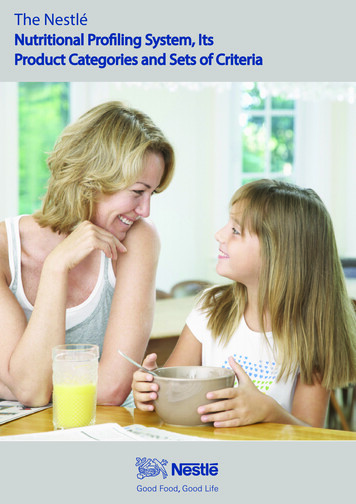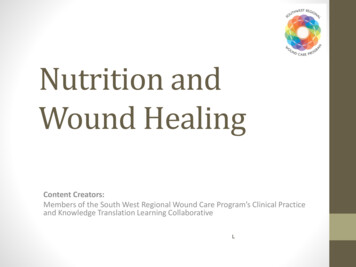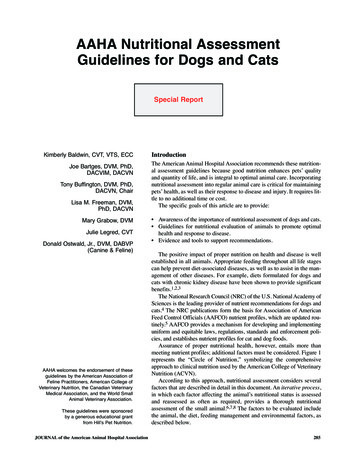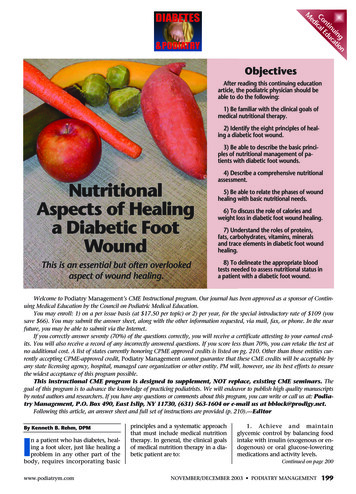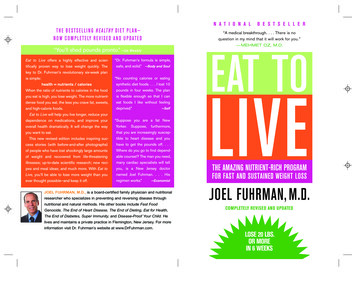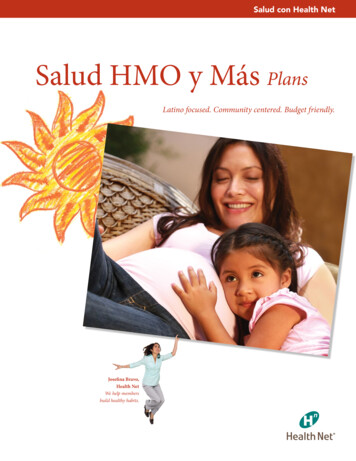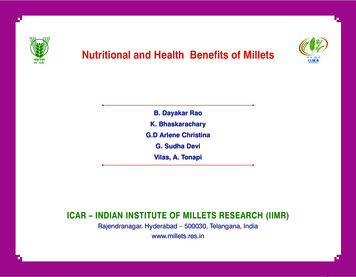
Transcription
Nutritional and Health Benefits of MilletsB. Dayakar RaoK. BhaskaracharyG.D Arlene ChristinaG. Sudha DeviVilas, A. TonapiICAR – INDIAN INSTITUTE OF MILLETS RESEARCH (IIMR)Rajendranagar. Hyderabad – 500030, Telangana, Indiawww.millets.res.inNutritional and Health Benefits of Millets F i
Printed on :June, 2017Citation:Dayakar Rao B., Bhaskarachary K., Arlene Christina G.D.,Sudha Devi G., Vilas, A. Tonapi, 2017,Nutritional and Health benefits of Millets.ICAR Indian Institute of Millets Research (IIMR)Rajendranagar, Hyderabad, PP 112ISBN :81-89335-68-5Copyright:ICAR-Indian Institute of Millets Research, HyderabadDisclaimer:@ Indian Council of Agricultural ResearchPublished by:Director, ICAR- Indian Institute of Millets Research, HyderabadCredits and photographs:HS Gawali, ICAR- IIMRDesigned by:V. Ramesh & V. RavinderPrinted at: Balajiscan Private Limited11-4-659, Bhavya’s Farooqui Splendid Towers,Flat No. 202, Beside Singareni Bhavan,Lakadikapul, Hyderabad-500004.Tel: 23303424/25, 9848032644
CPageNoONTENTSForeword12.2.1Cardiovascular Disease48Preface32.2.2Diabetes Milletus50Abbreviations42.2.3Gastro intestinal utive Summary1Millet Nutrition: The Tradition of India7-221.1Global Distribution and Production ofMillets91.2Distribution of Millets in India111.3Sorghum151.4Finger Millet151.5Pearl Millet1.63Sorghum55-603.1Nutritional Importance of Sorghum553.2Health Benefits of Sorghum57173.2.1Celiac Disease57Proso Millet173.2.2Obesity571.7Kodo Millet193.2.3Diabetes581.8Foxtail Millet193.2.4Coronary Heart Disease591.9Barnyard Millet213.2.5Cancer59213.2.6Oxidative Stress601.10 Little Millet2PageNoNutritional Importance and Health Benefits of Millets23-542.1Nutritional Importance of Millets232.2Health Benefits of Millets484Pearl Millet61-644.1Nutritional Importance of Pearl Millet614.2Nutritional facts of Pearl Millet62
CPageNo5ONTENTS67Finger MilletPageNo65-687.3Effect of Sorghum diet on GlycosilatedHemoglobin and Lipid Profile inpeople suffering from Diabetes765.1Nutritional Importance of Finger Millet655.2Health Benefits of Finger Millet667.4Amino acid profile of sorghum foods775.3Nutritional facts of Finger Millet677.5Effect of sorghum diet on nutritionalstatus of school going children7769-707.6Determination of protein efficiency ofsorghum79Small Millets6.1Nutritional Importance of Small Millets696.2Health Benefits of Small Millets70Nutritional Evaluation of Sorghum/MilletsFood Products - Findings from NIN & IIMRJoint Colloboration71-807.17.2Nutritional Composition of SorghumProcessed foods72Assessment of Glycemic Index (GI) andGlycemic Load (GL) of Sorghum foods7489Processing and Impact of Sorghum onNutritional Composition81-878.1Processing of Millets818.2Effect of grain processing on nutrientcomposition of sorghum products83Summary and Conclusions10 Reference89-9091-104
LIST OF FIGURESPageNoS.NoTitleFig 1General Structure Of Millet Grain7Fig 2Sorghum Panicles8Fig 3Finger Millet Panicles10Fig 4Pearl Millet Panicles12Fig 5Proso Millet Panicles14Fig 6Kodo Millet Panicles16Fig 7Foxtail Millet Panicles18Fig 8Barnyard Millet Panicles20Fig 9Little Millet Panicles22LIST OF TABLESPageNoTable 1.Proximate Composition and Dietary Fibre (per 100 g)24Table 2.Mineral and Trace Elements compared to fine cereals (mg/g of N)25Table 3.Water Soluble Vitamins profile of millets and major cereals27Table 4.Fat Soluble Vitamins profile of millets and major cereals28Table 5.Carotenoids profile of millets and major cereals29Table 6.Starch and Individual Sugars profile of millets and major cereals30Table 7.Fatty Acid Profile of millets and major cereals31Table 8.Amino Acid Profile of millets and major cereals32
PageNoTable 9.Properties of Dietary Fiber and their Health consequences36Table 9a.Composition of the Sorghum and control diets40Table 10.Phenolic acids detected in sorghum and millet grains42Table 11.Flavonoids and proanthocyanins reported in sorghum grains44Table 12.Proximate composition of sorghum processed foods (g/100g)72Table 13.Mineral Composition of sorghum processed products(per 100 g)73Table 14.Vitamin Composition of Sorghum food product (per 100 g)74Table 15.Glycemic Index and Glycemic Load of Test Foods and iAUC75Table 16.Mean glycosilated hemoglobin and lipid profile of diabetic patients before and after supplementation ofsorghum77Table 17 a.Nutritional status of school going children (girls) before and after sorghum supplementation78Table 17 b.Nutritional status of school going children (boys) before and after sorghum supplementation79Table 18.Total amino acids, amino acid score, total essential amino acids and limiting amino acids of sorghum foods(g/100g)80Table 19.AAS and PDCAAS values for sorghum calculated using 2002 WHO/FAO/UNU Expert Consultation recommendation80Table 20.Nutrient composition of whole sorghum grain and dehulled sorghum grain (Per 100g)84Table 21.Chemical, Mineral and Vitamin composition during milling process of sorghum (per 100 g).85Table 22.Macro and micro nutrient changes during sorghum processing (per 100g)86Table 23Nutrient composition after blending with other cereal grains with sorghum flour (per 100 g)87
FOREWORDMillets are a traditional staple food of the dry land regions of the world. In India, millets are grown on about17 million ha with annual production of 18 million tonnes and contribute 10 percent to the country’s foodgrain basket. They are nutri-cereals which are highly nutritious and are known to have high nutrient contentwhich includes protein, essential fatty acids, dietary fibre, B-Vitamins, minerals such as calcium, iron, zinc,potassium and magnesium. They help in rendering health benefits like reduction in blood sugar level (diabetes), blood pressure regulation, thyroid, cardiovascular and celiac diseases. However, the direct consumptionmillets as food has significantly declined over the past three decades.The major reasons of decrease in consumption is the lack of awareness of nutritional merits, inconveniencesin food preparation, lack of processing technologies, and also the government policy of disincentives towardsmillets and favoring of supply of fine cereals at subsidized prices. It has become imperative to reorient the efforts on the sorghum and millet crop to generate demand through value-addition of processed foods throughdiversification of processing technologies, nutritional evaluation and creation of awareness backed by backward integration. In that context it is important to explore ways for creating awareness on nutritional merits ofmillets.The importance of nutrition as a foundation for healthy development is underestimated. Now-a-days peopleare very conscious about their healthy living practices to overcome metabolic disorders and life style diseases.This publication deals with the review on the scientific empirical studies on the nutritional aspects, functionalaspects and health benefits of millets from seed structure to processed products, which are conducted in India and elsewhere across the globe. Further, it deals elaborately with nutritional evaluation of the value addedsorghum product technologies that have been developed and standardized under the IIMR-led consortium ofNAIP sub-project on millets value chain conducted by NIN. The products have shown to have high nutritionalvalues and the micronutrient studies conducted have reported, these to have relatively low glycemic index andglycemic load. Sorghum/millet processed products recipes and the method of preparation are embedded withcontent that can be of some use to various stakeholders, researchers, academic fraternity, consumers andentrepreneurs which is timely and is expected to help the researchers. It is hoped that the results published willcreate awareness and ensure that the highly nutritious millets consumption is popularized worldwide.Lastly, I congratulate Dr. B. Dayakar Rao, Principal Scientist and his co-authors for their efforts in bringing outthis valuable publication. This will go a long way in millet promotion in the country, given its potential for offering nutritional security. I hope the publication will be read and used widely.M S SwaminathanNutritional and Health Benefits of Millets F 1
2 F Nutritional and Health Benefits of Millets
PREFACEMillets are important crops for dry land farmers. They are highly nutritious and climate compliant crops.But due to drudgery in preparation, their consumption is decreased over the years in India. In orderto revive the demand of millets in India, there is need to enable to bring all the stakeholders in productionto consumption system value chain on a common platform and link poor dry land farmers with market andthe consumers at large. Under the NAIP sub-project on Millets Value Chain, an institutional mechanism wasestablished to form consortium of stakeholders in public-private partnership ensuring a win-win situation foreach stakeholder. The processing interventions were led to product development on sorghum products whosenutritional values were quite encouraging. Further quite a bit of data on nutrition and health benefits were generated under supervision of National Institute of Nutrition, Hyderabad. The micronutrient studies conductedwere reported in terminal report. It was reported that these products have relatively low glycemic index andglycemic load compared to wheat based products.Now the commercialization of products have extended for other millets too. Though the millet food productsare known for nutrition, its awareness among the consumers is scanty especially on their nutritional and therapeutic values. The health branding was not exploited enough to commercialize millet foods in the past, despitethe fact that, millets are known to have rich composition of nutrients and minerals.Therefore, this publication has been timely which deals with the review on empirical studies on the nutritionalaspects, functional aspects and health benefits of millets from seed structure to processed products, whichare conducted in India and elsewhere across the globe. Further, it deals elaborately with nutritional evaluationof the value added sorghum product technologies that have been developed and standardized under theIIMR-led consortium of NAIP sub-project on millets value chain conducted by NIN. This will go a long way inmillet promotion in the country, given its potential for offering nutritional security. I hope the publication will beread and used widely.Vilas, A . TonapiICAR - Indian Institute of Millets Research (IIMR) HyderabadNutritional and Health Benefits of Millets F 3
ABBREVIATION iAUCPositive Incremental Area Under CurveAASAmino Acid ScoreATPAdenosine Tri PhosphateARhaHACCPBMIBTLCDAbove the LineBody Mass IndexBelow the LineCeliac DiseaseCentral Food Technological ResearchNSPNon starchy polysaccharidesHazard Analysis and Critical ControlNGFNerve Growth FactorPointsNINNational Institute of NutritionHigh Performance Liquid Chromatog-Aldose ReductaseATLHectareNon Insulin Dependent DiabetesHPLCraphyNIDDMMilletusHDLHigh Density LipoproteinsNVIFNutritive Value of Indian FoodsICARIndian Council of Agricultural ResearchPD-Protein Digestibility Corrected AminoICMRIndian Council of Medical ResearchCAASAcid ScoreIDFInsoluble Dietary FibrePDSPublic Distribution SystemPIProtein Intakeq/haQuintal per hectareCFTRIInstituteICDSIntegrated Child Development ServicesCHDCoronary Heart DiseaseICRI-International Crop Research InstituteCHOCarbohydratesSATfor Semi-Arid TropicsCVDCardio Vascular DiseaseIIMRIndian Institute of Millets ResearchDPPH2,2-diphenyl-1-picryl hydrazylFAOFood and Agriculture OrganizationINSIMPFCIFood Corporation of IndiaKg/ haR andDResearch and DevelopmentRBPRetinol Binding ProteinIntensive Millets PromotionRTCReady to CookKilogram per hectareRTEReady to EatSoluble Dietary FibreInitiative for Nutrition Security throughFPFecal ProteinLDLLow Density LipoproteinsSDFGIGlycemic IndexMFPMetabolic fecal ProteinSDSSlow Digestible StarchGLGlycemic LoadMMAMacro Management in AgricultureTDFTotal Dietary FibreGoIGovernment of IndiaMDMMid Day MealVLDLVery Low Density LipoproteinsNational Agricultural Innovation ProjectWHOWorld Health OrganizationGSLGrain Sorghum Lipid4 F Nutritional and Health Benefits of MilletsNAIP
Executive SummaryMillets offer nutritional security and there is a need for promoting millets as they are highly nutritious. Thesehave been important food staples in human history, particularly in Asia and Africa. Sorghum and other milletsconsumption usage as direct food has significantly declined over the past three decades. The decline in demandhas led to the decline in millets production considerably in India. Production of sorghum in India has come downfrom 7 million tonnes during 2010-11 to 4.2 million tonnes during 2015-16; bajra production was reduced from 10.4million tonnes to 8.1 million tonnes, production of ragi reduced to 2.2 million tonnes to 1.8 million tonnes and smallmillets production came down to 0.39 million tonnes from 0.44 million tonnes during the same period. Accordingto the FAO statistics, 2017 millets production in the world was Sorghum (Sorghum bicolor (L.) Moench) is the fifthmajor cereal of the world after maize, paddy, wheat and barley as per FAO production data of 2014.This Nutritional Bulletin includes nutritional profile of Sorghum, Pearl millet, Finger millet, Foxtail millet, Commonmillet, Little millet, Barnyard millet and Kodo millet. Almost all the millets are used for human consumption in mostof the developing countries, but their use has been primarily restricted to animal feed in developed countries.Sorghum and millets are gluten free, hence, are useful dietary cereals. In general millets are rich source of fibre,minerals and B-complex vitamins. High fibre content and presence of some anti-nutritional factors like phytatesand tannins in millets affect bioavailability of minerals. Few studies in humans have suggested that absorption ofiron tends to be lower from millets than from rice or even wheat. (Rao et al.,1983). Millets are also rich in healthpromoting phytochemicals like polyphenols, lignans, phytosterols, phyto-oestrogens, phytocyanins. These functionas antioxidants, immune modulators, detoxifying agents etc. and hence protect against age-related degenerativediseases like cardiovascular diseases (CVD), diabetes, cancer etc. (Rao et al., 2011). Some of the known nutrientsvitamins, minerals, essential fatty acids also have benefits in terms of prevention of degenerative diseases besidestheir known functions of preventing nutritional deficiency diseases. Being non-glutinous, millets are safe for peopleNutritional and Health Benefits of Millets F 5
suffering from gluten allergy and celiac disease. They are non-acid forming, easy to digest and non-allergenic (Salehet al., 2013). Millets have potential for protection against age-onset degenerative diseases. Consumption of milletsreduces risk of heart disease, protects from diabetes, improves digestive system, lowers the risk of cancer, detoxifiesthe body, increases immunity in respiratory health, increases energy levels and improves muscular and neural systemsand are protective against several degenerative diseases such as metabolic syndrome and Parkinson’s disease(Manach et al., 2005; Scalbert et al., 2005; Chandrasekara and Shahidi, 2012). The important nutrients present inmillets include resistant starch, oligosaccharides, lipids, antioxidants such as phenolic acids, avenanthramides,flavonoids, lignans and phytosterols which are believed to be responsible for many health benefits (Miller, 2001; Edgeet al., 2005).This context of emerging need for alternating meal, fill the gap in the absence of essential nutrients, IIMR has done acommendable research in various value added Convenient products without much loss of minerals in view sorghumwith an upgradation of DSR to IIMR. Now the research is not just limited to Sorghum but widens to other millets too.The recipes formulated at Indian Institute of Millets Research (IIMR) upgraded from Directorate of Sorghum Research(DSR), a central agency under ICAR to work on Sorghum formerly but now with an upgradation, all the aspectsof millets are included and research and development is undertaken. The sub-project of NAIP-Millets Value Chainfocuses on such an effort on selected millet foods with special case of sorghum; given the model is successful, it canbe replicated to other millets which can be of great use to consumers, households and entrepreneurs where theycan practice and prepare different methods of preparation of value added products with health benefits which are notavailable in the market, these value added products can combat the nutritional deficiency disorders. The preparationand production of such products by households, entrepreneurs, self-help groups, small scale industries and largescale industries can raise their income level by promoting the value added products. By promotion of these Valueadded products can improve the socio- economic status and also health status of the consumers. The synergicefforts resulted various nutritionally rich convenient sorghum product technologies were developed and successfullycommercialized on pilot scale at Hyderabad. Scientific empirical studies conducted on various products have shownthat the recipes such as idli, dosa, etc with sorghum and other millets as that of rice, wheat etc. Implementationof effective promotional strategies and policy sensitization attracted entrepreneurs and policy makers to considersorghum as priority6 F Nutritional and Health Benefits of Millets
Chapter-1Millet Nutrition:The Tradition of India1. INTRODUCTIONMillets are a group of highly variable small seeded grasses,widely grown around the world as cereal crops orgrains for fodder and human food. They do not forma taxonomic group, but rather a functional or agronomicone. Millets are important crops in the semi-arid tropics ofAsia and Africa (especially in India and Nigeria), with 97%of millet production in developing countries. The crop isfavoured due to its productivity and short growing seasonunder dry, high-temperature conditions. The most widelygrown millet is pearl millet, which is an important crop in Indiaand parts of Africa. Finger millet, Proso millet, and Foxtailmillet are also important crop species. In the developedworld, millets are less important. For example, in the UnitedStates only Proso millet is significant, and it is mostly grownfor bird seed. While millets are indigenous to many parts ofthe world, it is believed that they had an evolutionary originFig. 1 General structure of millet grainNutritional and Health Benefits of Millets F 7
Fig. 2 Sorghumpanicles8 F Nutritional and Health Benefits of Millets
in tropical western Africa, as that is where the greatest number of both wild and cultivated forms exist. Millets have beenimportant food staples in human history, particularly in Asia and Africa. They have been in cultivation in East Asia for the last10,000 years.Sorghum and millets have been important staples in the semi-arid tropics of Asia and Africa for centuries. These cropsare still the principal sources of energy, protein, vitamins and minerals for millions of the poorest people in these regions.Sorghum and millets are grown in harsh environments where other crops grow or yield poorly. They are grown with limitedwater resources and usually without application of any fertilizers or other inputs by a multitude of small-holder farmers inmany countries. Therefore, they are mostly consumed by disadvantaged groups; they are often referred to as “coarse grain”or “poor people’s crops”. They are not usually traded in the international markets or even in local markets in many countries.The farmers seldom, therefore, have an assured market in the event of surplus production. The cereals considered in thispublication include sorghum, Pearl millet, Finger millet, Foxtail millet, Common millet, Little millet, Barnyard millet and Kodomillet. Teff (Eragrostis tef), which is extensively cultivated in Ethiopia, is not strictly a millet and is therefore not included.Other millets such as fonio (Digitaria exilis) and Job’s tears (Coix lancryma -jobi) are of minor importance.1.1 Global Distribution and Production of MilletsAccording to FAO statistics (2009), the world production of millets was 26.7 million metric tonnes from an area of 33.6million hectare. Nearly a decade earlier (2002), the world production of millets was down to 23.3 million metric tonsfrom an area of 33.3 million hectare. Africa was the largest producer of millet in 2009 (20.6 million metric tonnes),followed by Asia (12.4 million metric tonnes) and India (10.5 million metric tonnes). Relative to wheat, rice, maize andbarley, sorghum ranks fifth in importance, in terms of both production and area planted, accounting for 5% of theworld cereal production (Obilana, 2002)Global ProductionThe global production of pearl millets has come down from 32.8 million tonnes in 2010 to 28.4 million tonnes during2014. Asia and Africa are the major contributors of worlds total pearl millets production contributing more than 98%Nutritional and Health Benefits of Millets F 9
Fig. 3 Finger millet panicles10 F Nutritional and Health Benefits of Millets
of the global production. The share of African countries in global millets production has come down from 49.22% in2010 to 43.72% during 2014, whereas the contribution from Asian countries has increased to 52.25% from 48.72%during 2010. Sorghum (Sorghum bicolor (L.) Moench) is the fifth major cereal of the world after maize, paddy, wheatand barley as per FAO production data of 2016. The world sorghum production increased significantly during 2014 to68.9 million tonnes from 60 million tonnes in 2010, after a drastic reduction in 2011 to 57 million tonnes. African stoodto be largest producer of sorghum during 2014 contributing about 42% of global production followed by Americas(39.75%) and Asia (14.04%).1.2 Distribution of Millets in IndiaIndia is the top most producers of millets followed by Nigeria for the year 2000 and 2009. In India, eight milletsspecies (Sorghum, Pearl millet,Finger millet, Foxtail millet, Kodo millet, Proso millet, Barnyard millet and Little millet)are commonly cultivated under rain fed conditions. Further, in each of the millet growing areas at least 4 to 5 speciesare cultivated either as primary or allied crop in combination with the pulses, oilseeds, spices and condiments. Forinstance, while pearl millet and sorghum are primary crop and allied crops respectively in the desert regions ofRajasthan, in the eastern parts of Rajasthan and Gujarat it is the opposite. Similarly, sorghum is sown as major crop inthe Telangana, Andhra Pradesh, Maharashtra and parts of Central India, while it is considered as fodder crop in someof the Southern regions.Likewise, Finger millet is a primary crop in Tamil Nadu and Gujarat, while the same is a minor crop in Telangana.Hence, the spatial distribution of millets either as a primary crop or as allied crops largely depends on the growinghabitat and the amount of rainfall the region receives. While sorghum predominates in areas receiving annual rainfallbeyond 400 mm, pearl millet rivals it in areas with annual rainfall of 350 mm. Further, the small millets like fingermillet, foxtail millet, barnyard millet, little millet and proso millet are found in most of the southern and central states inIndia especially wherever annual rainfall is below 350 mm, perhaps where no other cereal crop can grow under suchmoisture stress.Nutritional and Health Benefits of Millets F 11
Fig. 4 Pearl millet panicles12 F Nutritional and Health Benefits of Millets
However, in spite of a rich inter/intra-species diversity and wider climatic adaptability cultivation of diverse milletspecies/varieties is gradually narrowing in the recent past. In a way, a lack of institutional support for millet crops incontrast to the institutional promotion of rice and wheat continue to shrink the millet-growing region. In spite of this,several communities in the dry/rain fed regions having known the food qualities of millets over generations continue toinclude a range of millets in the traditional cropping patterns, which recognize millet as an essential part of the milletdiet.Vernacular Names of milletKodomilletFoxtail/ ItalianmilletBarnyardmilletProso uRaguluSamaluArikelu,ArikaKorra, iJcwariBajriNachniSavaKodraKang, RalaShamulVariGujaratiJuarBajriNagli, huka,MandhalSwankKodraKangniSwankCheenaNutritional and Health Benefits of Millets F 13
Fig. 5 Proso millet panicles14 F Nutritional and Health Benefits of Millets
1.3 SorghumSorghum (Sorghum bicolor (L.) Moench) is a warm season crop, intolerant of low temperatures but fairly resistant toserious pests and diseases. It is known by a variety of names (such as great millet and guinea corn in West Africa, Asiaand parts of Middle East). Most of the sorghum produced in North and Central America, South America and Oceaniais used for animal feed (FAO, 1995).The grain consists of naked caryopsis, made up of a pericarp, endosperm and germ. Although there is a huge rangeof physical diversity, sorghum are classed into four groups: (1) grain sorghum, (2) forage sorghum glum; (3) grasssorghum; or (4) Sudan sorghums and broomcorn (Macraeet al., 1993) (Fig. 1). Sorghums are grouped using thefollowing characteristics (Fig. 2). The color of the pericarp (white, yellow or red) Presence or absence of pigmented testa (with/without tannins) Pericarp thickness Endosperm color (white, hetero yellow or yellow) Endosperm type (normal, hetero waxy or waxy)1.4 Finger MilletFinger millet (Eleusine coracana (L.) Gaertn) is a cereal grass grown mostly for its grain (Fig. 3). Finger millet is a robust,tufted, tillering annual grass, up to 170 cm high (FAO, 2012; De Wet, 2006; Quattrocchi, 2006). The inflorescenceis a panicle with 4-19 finger-like spikes that resembles a fist when mature, hence the name finger millet (de Wet,2006; Quattrocchi, 2006). The spikes bear up to 70 alternate spikelets, carrying 4 to 7 small seeds (Dida et al., 2006).The seed pericarp is independent from the kernel and can be easily removed from the seed coat (FAO, 2012).Finger millet is a staple food in many African and South Asian countries. It is also considered a helpful famine cropas it is easily stored for lean years (FAO, 2012). The grain is readily digestible, highly nutritious and versatile, andNutritional and Health Benefits of Millets F 15
Fig. 6 Kodo millet panicles16 F Nutritional and Health Benefits of Millets
can be cooked like rice, ground to make porridge or flour, or used to make cakes (De Wet, 2006). Sprouted grainsare recommended for infants and elderly people. Finger millet is also used to make liquor (arake or areki in Ethiopia)and beer, which yields by-products used for livestock feeding (FAO, 2012). Finger millet grain is not widely used forlivestock: it is primarily a food grain, but it is of lesser quality for livestock than maize, sorghum and pearl millet.In India, it is sometimes used for feeding infant calves, growing animals, as well as sick and convalescing animals(Sampath, 1986)1.5 Pearl MilletPearl millet (Pennisetum glaucum (L.) R. Br.) (Fig. 4) originated in Central tropical Africa and is widely distributed inthe drier tropics and India. It was introduced into the Western state in the 1850’s and became established as minorforage in the Southeast and Gulf Coast states. The plant was probably domesticated as a food crop some 4000to 5000 years ago along the Southern margins of the Central highlands of the Sahara. It has since become widelydistributed across the semiarid tropics of Africa and Asia. Pearl millet has traditionally been an important grain, forage,and stover crop primarily in the arid and subtropical regions of many developing countries. As pearl millet cultivationexpands into non-traditional areas in temperate and developed countries, production constraints from diseases areassuming greater importance. Dissemination of accurate information on diseases of the crop has not kept pace withthe increased interest in pearl millet as a viable crop in non-traditional areas. Pearl millet is well adapted to growingareas characterized by drought, low soil fertility, and high temperature. It performs well in soils with high salinity or lowpH. Because of its tolerance to difficult growing conditions, it can be grown in areas where other cereal crops, suchas maize or wheat, would not survive.1.6 Proso MilletProso millet (Panicum miliaceum (L.)) is an annual grass, growing from seed each year (Fig. 5). Its origin goes back inhistory at least as far as 2000 B.C. when it is reported to have been grown in the Central regions of Europe. This plantis especially well suited to dry climates such as Central Russia, the Middle East, Northern India, Africa, Manchuria, andNutritional and Health Benefits of Millets F 17
Fig. 7 Foxtail millet panicles18 F Nutritional and Health Benefits of Millets
the Great Plains area of North America. Proso millet was first introduced to Canada in the 17th century, and was usedin a limited way as a forage crop in the early 1900’s.Proso millet is a relatively low demanding crop and diseases aren’t known. That’s why Proso millet is often used inorganic farming systems in Europe.
1.5 Pearl Millet 17 1.6 Proso Millet 17 1.7 Kodo Millet 19 1.8 Foxtail Millet 19 1.9 Barnyard Millet 21 1.10 Little Millet 21 2 Nutritional Importance and Health Bene-fits of Millets 23-54 2.1 Nutritional Importance of Millets 23 2.2 Health Benefits of Millets 48 Page No 2

